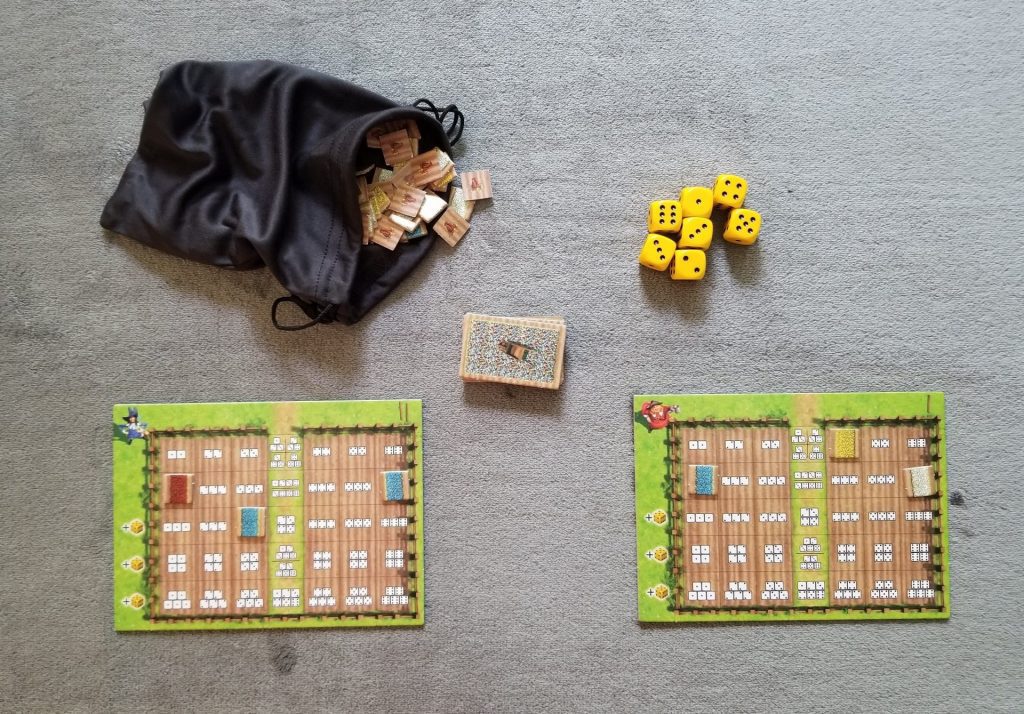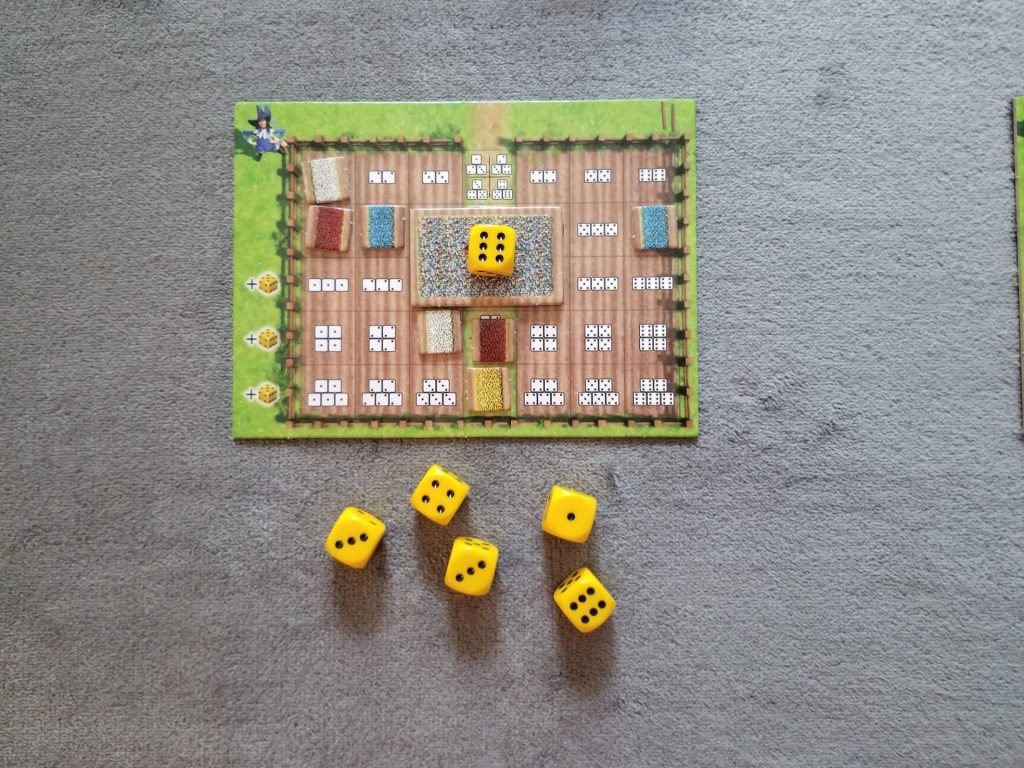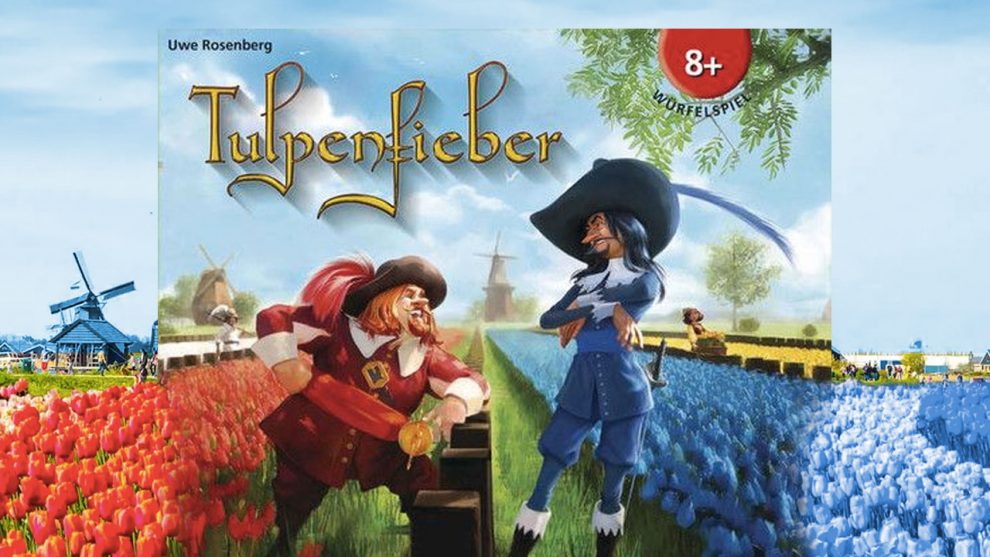From wikipedia: “Tulpenmanie (Dutch for ‘tulip mania’) was a period during the Dutch Golden Age when contract prices for some bulbs of the recently introduced and fashionable tulip reached extraordinarily high levels, with the major acceleration starting in 1634 and then dramatically collapsing in February 1637. It is generally considered to have been the first recorded speculative bubble or asset bubble in history.”
The game of Tulpenfieber (German for ‘tulip fever’) takes place during this very strange period in humankind’s short, but glorious history. The players take on the roles of farmers trying to cash in on this blossoming craze. Out with the corn and barley! In with the tulips!
Using a Yahtzee-like dice rolling mechanic, players are going to be racing to fill their farms with Tulip tiles in order to satisfy one of the game winning criteria before their opponents. Each round a handful of dice gets rolled and then the active player will place a Tulip tile into their fields according to the result. Placing certain tiles in particular arrangements will unlock extra dice in future turns, while others will unlock bonus tiles that allow a player to have some control over future dice roll outcomes. The game ends immediately once one of the players has fulfilled an end condition.
Sowing the Seeds
Setting up Tulpenfieber is simple. Each player is given a Tulip field based on their position in turn order (they’re all slightly different). The boards have several flower icons on them and the players will cover these with a Tulip tile turned tulip side up. The color of the tile doesn’t matter. The remaining Tulip tiles can be placed back into the cloth bag. Then the dice are set close by along with the Bonus tiles. That’s it. Now you’re ready to begin.

On your turn, you’ll pick up four of the dice (more if you’ve unlocked them) and roll them up to three times, setting aside any dice you want to keep or bringing back dice previously set aside before each roll. After the third roll, if you’re still not satisfied, you can flip two of your Tulips tiles (provided you have them to flip) to their money bag sides to purchase an extra reroll. Then you can do this again for a fifth, and final roll, at which point you’re stuck with your results.

After having rolled your dice, you’ll take a Tulip tile and attempt to add it to your Tulip field. If it can’t legally be added somewhere, it’s placed tulip side up above the Tulip field and can be used to purchase re-rolls later. In order to add a Tulip tile to a space, a portion of your final dice roll must match the pattern shown on that space. The middle column of the Tulip field requires specific runs of numbers while the other columns require multiples of the same number. So, if you rolled four dice and came up with four 4s, then you could satisfy the condition of a space asking for a double four, a triple four, or a quadruple four.
The Wonders of Tulips
Aside from purchasing re-rolls, planting tulips into your field serves a few other purposes as well. First, it’s how you unlock extra dice. Second, it’s how you can earn Bonus tiles that allow you to program dice on future turns. Lastly, it’s how you win the game.
Each Tulip field is composed of five rows. The bottom three rows have an icon to the left of them that depicts a die and a +1. This indicates that if you’re able to construct a line of Tulip tiles from this row to the top row (vertically or diagonally), then you’ll be rolling an extra die at the beginning of each subsequent turn. You begin the game rolling four dice, but can eventually gain an extra three.

If you are ever able to construct a two by three grouping of Tulip tiles in your field, then you can cover these tiles with a Bonus tile. Each Bonus tile features a wheelbarrow. On future turns, you can place one of your dice to a face of your choosing on top of the wheel barrow. You can keep the face you’ve chosen or change it if you so choose.
Lastly, the first player to complete any of the following three conditions wins the game automatically: add Tulips tiles to all seven spaces in row four, add three consecutive Tulip tiles to row five, or add a total of four Tulip tiles to row five.
Thoughts
2021 was a light year for Uwe Rosenberg, both in terms of production and game weight (literally and metaphorically). Kicking it off with Armonia and culminating with this game, Uwe seemed to be on a dice game kick. And, as I mentioned in my review of Armonia, he also seems to be on a racing game kick as well. Excluding his earlier work such as Spelunke or Titus (each of which consists of a single deck of cards) and thinking about his more modern titles, Armonia and Tulpenfieber are some of the most component sparse and lightest game weight games he has ever produced. But that doesn’t mean they’re devoid of any redeeming qualities.
It’s easy to look at a dice driven game and assume it’s all just random luck (and that’s because it usually is). Dice are very deterministic. And it’s easy to look at a game like Tulpenfieber and compare it to a game like Yahtzee, one of the most basic of basic board games, and assume there isn’t much meat on its bones. The two games share a lot of similarities from the way that dice are rolled, kept, and dismissed right down to the way that you’re forced to choose what to do with the results. Having made that comparison, it would be easy to assume that Tulpenfieber is also a basic board game. And that might leave you feeling somewhat disappointed. After all, how could a stellar designer such as Uwe Rosenberg, the brilliant mind behind Agricola and A Feast For Odin also design such a simplistic game so far into his illustrious career? It would be like Vital Lacerda coming out with a children’s game.
I must admit that being the Rosenberg nerd that I am, I have put Uwe onto a pedestal, a board game design god among mortal men. And, in doing so, I have forgotten that Uwe Rosenberg is just another human like the rest of us, albeit one who is really good at designing board games. While I cannot speak for him, there are some things I can glean from outside sources that may provide some insight into why Uwe Rosenberg’s designs over the past few years have been a little less Hallertau and a little more Sagani. The game magazine Spielbox interviewed him during their coverage of Hallertau in one of their issues from 2020 and this is what was said:
“As the author announced, Hallertau is expected to be the final chapter of Rosenberg’s agriculture-themed games. But maybe the final word has not yet been spoken, and it is not completely ruled out that Rosenberg might think again about worker placement and harvest themes. ‘However, that’s not so easy to do with four children,’ he says. There is not enough peace and quiet for such a substantial project. ‘If I totally immerse myself in such a game, this would only be possible at the expense of the family.’”
Having read this, I begin to see his latest projects in a new light. It isn’t that Uwe Rosenberg is becoming a lesser game designer. It’s that he’s straddling the line between designing games for a newer, younger, and more familial audience while also striving to please his existing fans. And he’s doing a damn good job of it. Tulpenfieber, while no masterpiece of game design, is still a very enjoyable game as long as you go into it with the right mindset, an appreciation of a game designed by a father of four children, a gamer’s game for children and a children’s game for gamers.
Yahtzee, for those unfamiliar, is a game in which the players take turns rolling dice and using the results to fill out a pad of paper. I explained the particulars about how to play in more detail in my Roll and Write Board Game Step Ladder article, so I’m not going to go into a ton of detail here. Suffice to say, the goal of that game is to score the most points. Tulpenfieber provides a similar experience (sans the pen and paper) but flips the script by turning it into a race instead. And that, dear reader, makes all the difference.
Now your decisions matter even more. In the hypothetical example I provided earlier in this review where you’ve rolled up four 4s, what do you do? Covering up a space in the upper three rows services the quest for extra dice, but placing a die into the fourth row puts you one step closer to winning. So, what’s the right call? And if you rolled up three 4s instead, should you flip over your Tulip tiles to purchase a reroll in the hopes of getting a fourth or do you hang onto your Tulip tiles until you’re much closer to winning the game? If you’re one spot away from being able to claim a Bonus tile and have rolled up a sequence of dice that could either satisfy the sixth spot or fill in a space on the fourth or fifth rows, should you go for the Bonus tile? Or would the better move be to fill in one of the spots needed to win the game? In every game I have played, there have been multiple people one single lucky die roll away from winning, so these little micro-decisions are really important.
While it isn’t the best game that Uwe Rosenberg has ever put out, Tulpenfieber is still a respectable one. It’s a very easy game to play with each game only taking around 30 minutes to complete. It’s small and portable which means you can tuck into a purse or a backpack with ease. It’s got a small footprint making it an excellent candidate for a “games you can play on an airplane” list. Plus, most importantly, it’s a lot of fun. And, when it comes to games, isn’t that all that really matters?











Add Comment